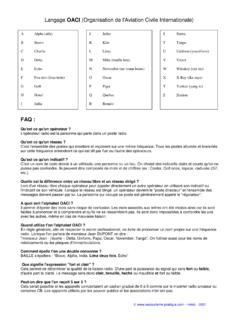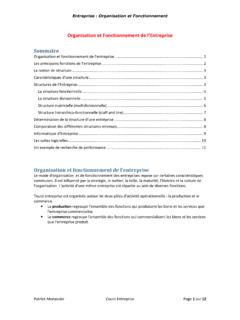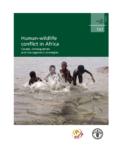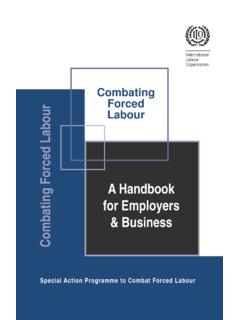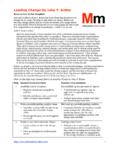Transcription of THE ECONOMIC IMPACT OF COUNTERFEITING AND …
1 THE ECONOMIC IMPACT OF COUNTERFEITING AND PIRACY Executive Summary organisation FOR ECONOMIC CO-OPERATION AND DEVELOPMENT The OECD is a unique forum where the governments of 30 democracies work together to address the ECONOMIC , social and environmental challenges of globalisation. The OECD is also at the forefront of efforts to understand and to help governments respond to new developments and concerns, such as corporate governance, the information economy and the challenges of an ageing population. The organisation provides a setting where governments can compare policy experiences, seek answers to common problems, identify good practice and work to co-ordinate domestic and international policies. The OECD member countries are: Australia, Austria, Belgium, Canada, the Czech Republic, Denmark, Finland, France, Germany, Greece, Hungary, Iceland, Ireland, Italy, Japan, Korea, Luxembourg, Mexico, the Netherlands, New Zealand, Norway, Poland, Portugal, the Slovak Republic, Spain, Sweden, Switzerland, Turkey, the United Kingdom and the United States.
2 The Commission of the European Communities takes part in the work of the OECD. OECD Publishing disseminates widely the results of the organisation s statistics gathering and research on ECONOMIC , social and environmental issues, as well as the conventions, guidelines and standards agreed by its members. This work is published on the responsibility of the Secretary-General of the OECD. The opinions expressed and arguments employed herein do not necessarily reflect the official views of the organisation or of the governments of its member countries. OECD 2007 No reproduction, copy, transmission or translation of this document may be made without written permission. Applications should be sent to THE ECONOMIC IMPACT OF COUNTERFEITING AND PIRACY: Executive Summary 3 OECD 2007 Table of Contents Key findings and I. II. The markets for counterfeit and pirated III.
3 The situation in COUNTERFEITING and IV. V. VI. Improving information on COUNTERFEITING and piracy and strengthening VII. Efforts to combat COUNTERFEITING and 4 THE ECONOMIC IMPACT OF COUNTERFEITING AND PIRACY: Executive Summary OECD 2007 COUNTERFEITING and Piracy What we know and what could be done Overview: Magnitude and effects of COUNTERFEITING and piracy necessitate strong action Analysis carried out in this report indicates that international trade in counterfeit and pirated products could have been up to USD 200 billion in 2005. This total does not include domestically produced and consumed counterfeit and pirated products and the significant volume of pirated digital products being distributed via the Internet. If these items were added, the total magnitude of COUNTERFEITING and piracy worldwide could well be several hundred billion dollars more. COUNTERFEITING and piracy are illicit businesses in which criminal networks thrive.
4 The report shows that the items that they and other counterfeiters and pirates produce and distribute are often substandard and can even be dangerous, posing health and safety risks that range from mild to life-threatening. Economy-wide, COUNTERFEITING and piracy undermine innovation, which is key to ECONOMIC growth. The magnitude and effects of COUNTERFEITING and piracy are of such significance that they compel strong and sustained action from governments, business and consumers. More effective enforcement is critical in this regard, as is the need to build public support to combat the COUNTERFEITING and piracy. Increased co-operation between governments, and with industry, would be beneficial, as would better data collection. Main elements of the report Analyses the structure of the markets for counterfeit and pirated products; the analysis highlights the importance of distinguishing those consumers who knowingly purchase counterfeit or pirated products, from those who are deceived; Assesses the scope of products being counterfeited and pirated; Examines the principal factors driving production and consumption; Estimates the potential magnitude of counterfeited and pirated goods in international trade, based on a new econometric model; Establishes and applies a 17-point framework for assessing the effects of COUNTERFEITING and piracy economy-wide, as well as on rights holders, consumers and governments; Presents a framework for assessing the effectiveness of the policies and related initiatives being pursued to combat COUNTERFEITING and piracy.
5 Describes and evaluates the main national and international initiatives being taken by governments and business to combat COUNTERFEITING and piracy; Examines in detail the situation in the audio-visual, automotive, electrical components, food and drink, pharmaceutical and tobacco sectors; Outlines ways that information and analysis on COUNTERFEITING and piracy could be strengthened; and Suggests areas where policies and practices to combat COUNTERFEITING and piracy could be strengthened. THE ECONOMIC IMPACT OF COUNTERFEITING AND PIRACY: Executive Summary 5 OECD 2007 Key findings and recommendations The report suggests ways to develop information and analysis, and calls on governments to consider strengthening legal and regulatory frameworks, enhance enforcement and deepen the evaluation of policies, programmes and practices. Market analysis Critical to developing an effective response The market for counterfeit and pirated products can be divided into two important sub-markets.
6 In the primary market, consumers purchase counterfeit and pirated products believing they have purchased genuine articles. The products are often sub-standard and carry health and safety risks that range from mild to life-threatening. In the secondary market, consumers looking for what they believe to be bargains knowingly buy counterfeit and pirated products. The policies and measures to combat COUNTERFEITING and piracy in the two markets differ; it is therefore important to know how much of a threat each poses when considering product-specific strategies. The study identifies a number of factors that are important to understanding why some products are counterfeited or pirated more frequently than others, and why COUNTERFEITING and piracy are more common in certain parts of the world than others. The factors provide a framework for assessing the propensity of a product to be counterfeited or pirated, which can be used to guide quantitative research.
7 They can also be used to suggest areas where government and industry should focus efforts to combat the illicit operations. The propensity framework is applied to the analysis of the six sector case studies included in the report. Magnitude and scope Larger than the national GDPs of 150 economies and affecting nearly all product sectors The study shows that counterfeit and pirated products are being produced and consumed in virtually all economies, with Asia emerging as the single largest producing region. In recent years there has been an alarming expansion of the types of products being infringed, from luxury items (such as deluxe watches and designer clothing), to items that have an IMPACT on personal health and safety (such as pharmaceutical products, food and drink, medical equipment, personal care items, toys, tobacco and automotive parts). With respect to magnitude, the study notes that promising work has been done in a number of sectors to measure the extent of COUNTERFEITING and piracy, but that much more can and should be done.
8 The situation of each industry is unique, therefore techniques for carrying out such analysis need to be tailored to the sectors concerned. To date, no rigorous quantitative analysis has been carried out to measure the overall magnitude of COUNTERFEITING and piracy. This report notes the difficulties that would need to be addressed before such an estimate could be made, and then presents a methodology for estimating the role of COUNTERFEITING and piracy in international trade, which is only a part, albeit an important one, of the total picture. 6 THE ECONOMIC IMPACT OF COUNTERFEITING AND PIRACY: Executive Summary OECD 2007 An analysis of international trade data (landed customs value basis1) was carried out using the methodology; it suggests that up to USD 200 billion of internationally traded products could have been counterfeit or pirated in 2005. This amount is larger than the national GDPs of about 150 economies2.
9 The figure does not, however, include counterfeit and pirated products that are produced and consumed domestically, nor does it include non-tangible pirated digital products being distributed via the Internet. If these items were added, the total magnitude of COUNTERFEITING and piracy worldwide could well be several hundred billion dollars more. Effects Broad and profound The report presents and applies a framework for assessing the effects of counter-feiting and piracy. Included in the analysis are assessments of the (i) general socio- ECONOMIC effects (on innovation and growth, criminal activities, environment, employment, foreign direct investment, and trade), (ii) effects on rights holders (on sales volume and prices, brand value and firm reputation, royalties, firm-level investment, costs and the scope of operations), (iii) effects on consumers (health and safety risks and consumer utility) and (iv) effects on government (tax revenues, expenditures and corruption).
10 The analysis shows that criminal networks and organised crime thrive via COUNTERFEITING and piracy activities. The items that counterfeiters and pirates produce are often substandard, sometimes endangering the lives of those who purchase them. These illicit activities steal market share from legitimate businesses and undermine innovation, with negative implications for ECONOMIC growth. Bribery associated with COUNTERFEITING and piracy weakens the effectiveness of public institutions at the expense of society at large. Moreover, the savings that consumers may achieve by knowingly purchasing lower-priced counterfeit or pirated products need to be considered in a broader context. Depending on the product, consumers can be worse off. In some cases, consumers seeking to save money may be exposing themselves to health and safety risks when the products concerned are substandard.











